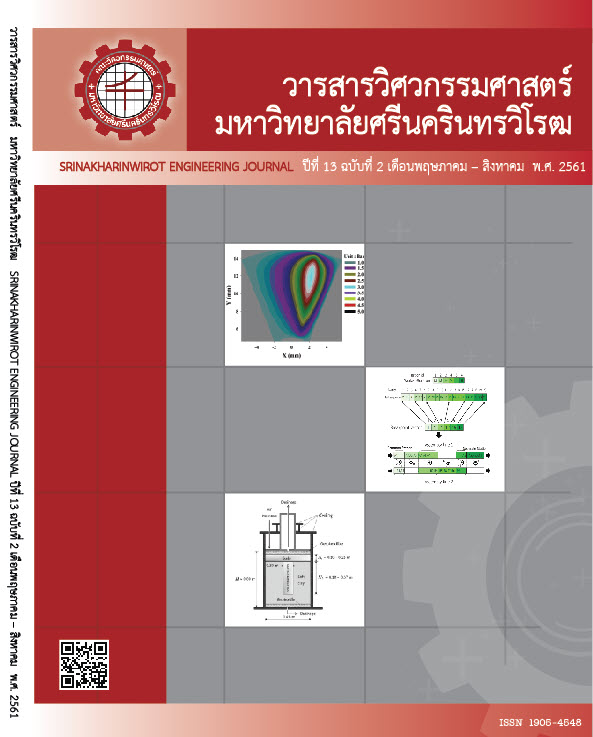การวิเคราะห์องค์ประกอบเชิงยืนยันปัจจัยความสำเร็จ โครงการการจัดซื้อจัดจ้างก่อสร้างภาครัฐ
Main Article Content
บทคัดย่อ
การวิจัยครั้งนี้มีจุดมุ่งหมายเพื่อตรวจสอบความกลมกลืนของปัจจัยความสำเร็จโครงการการจัดซื้อจัดจ้างงานก่อสร้างภาครัฐกับข้อมูลเชิงประจักษ์ เก็บข้อมูลกับบุคลากรในหน่วยงานภาครัฐ จำนวน 353 คน ด้วยแบบสอบถามแบบมาตราส่วนประมาณค่า 5 ระดับ จำนวน 22 ข้อ มีค่าความเที่ยงตรงเชิงเนื้อหา (IOC) จากผู้เชี่ยวชาญ 5 ท่านอยู่ระหว่าง 0.50 ถึง 0.10 และมีค่าความเชื่อมั่นทั้งฉบับ เท่ากับ .986 วิเคราะห์ข้อมูลด้วยเทคนิคการวิเคราะห์องค์ประกอบเชิงยืนยันอันดับที่สอง ผลการวิจัย พบว่า ความสำเร็จต่อโครงการการจัดซื้อจัดจ้างก่อสร้างภาครัฐ มี 4 องค์ประกอบหลัก ได้แก่ หลักการและเหตุผล/ขอบเขตและการครอบคลุม ด้านการบริหารโครงการ ด้านนิติกรรมและสัญญา และด้านบริหารและการจัดการ และความแปรปรวนที่อธิบายความสำเร็จในการจัดซื้อจัดจ้างโครงการก่อสร้างภาครัฐได้ร้อยละ 61.2 โดยค่าน้ำหนักองค์ประกอบที่สูงที่สุด คือ ด้านหลักการและเหตุผล (β = 0.827) รองลงมา คือ ด้านการบริหารโครงการ (β = 0.817) ด้านนิติกรรมและสัญญา (β = 0.794) และด้านการบริหารและการจัดการ (β =0.744) ตามลำดับ
Article Details
ลิขสิทธิ์เป็นของวารสารวิศวกรรมศาสตร์ มหาวิทยาลัยศรีนครินทรวิโรฒ
References
[2] V. Miller, Understanding Digital Culture, London, SAGE Publications Ltd., 2011.
[3] กองบริหารงานวิจัยและประกันคุณภาพการศึกษา. (23 ธันวาคม 2559). พิมพ์เขียว Thailand 4.0 โมเดลขับเคลื่อนประเทศไทยสู่ความมั่งคั่ง มั่นคง และยั่งยืน, [ระบบออนไลน์], แหล่งที่มา: www.libarts.up.ac.th/v2/img/Thailand-4.0.pdf.
[4] คณะกรรมการพัฒนาเศรษฐกิจและสังคมแห่งชาติ สำนักงาน. (20 มีนาคม 2558). การจัดทำแผนพัฒนาเศรษฐกิจและสังคมแห่งชาติ ฉบับที่ 12 (พศ.2560-2564), [ระบบออนไลน์], แหล่งที่มา: http://www.nesdb.go.th/more_news.php?cid=297
[5] H. Walker and S. Brammer, “Sustainable procurement in the United Kingdom public sector,” Supply Chain Manage., vol. 14, no. 2, pp. 128-137, 2009.
[6] S. Khoman, M. Wanrak, T. Vatcharceya, T. Chayun, C. Chatchai, S Sutthi, N. Sittikorn, and S. Napon, “The world trade organisation’s government procurement Agreement: A Study of Thailand’s preparation for accession,” Research report, The Comptroller-General’s Department, Ministry of Finance., Bangkok, October 2009.
[7] M. Podlogar, “E-Procurement Success Factors: Challenges and Opportunities for a Small Developing Country,” PA: IDEA Group Publishing, 2007, pp. 34-75.
[8] T. R. Berkland, “Performance based contracting and improving the current contracting process,” M.S. Thesis, Dept. Civil Eng., Clemson University, USA, 2007.
[9] B. Aschhoff and W Sofka, “Innovation on Demand: Can public procurement drive market success of innovations,” Research Policy, vol 38, no. 8, pp. 1235-1247, 2008.
[10] H. Doloi, K.C. lyer and A. Sawhney, “Structural equation model for assessing impacts of contractor's performance on project success,” Inter. J. Proj. Manage., vol. 29, pp. 687-695, 2011.
[11] N. Gudiene, A. Banaitis, N. Banaitiene and J. Lopes. “Development of a conceptual critical success factors model for construction projects: a case of Lithuania,” in 11th International Conference on Modern Building Materials, Structures and Techniques, Lithuania: Elsevier, 2013, pp. 392-397.
[12] S. M. H. M. Al-tmeemy, H. abdul-Rahman and Z. Harun, “Future criteria for success of building projects in Malaysia,” Inter. journal of PM, vol. 29, no. 3., pp. 337-348, 2011.
[13] J. I. Alzahrani, and M. W. Emsley, “The impact of contractors’ attributes on construction project success: A post construction evaluation,” Inter. J. Proj. Manage., vol. 31, no. 2., pp. 313-322, 2013.
[14] A. P. Field, Discovering Statistics Using IBM SPSS Statistics, London, SAGE Publications Ltd., 2012.
[15] W. Lawrence Neuman, Social Research Methods: Qualitative and Quantitative Approaches, Boston: Pearson/AandB, 2006.
[16] ชัยวิชิต เชียรชนะ. “การใช้สถิตหลายตัวแปรเพื่อการวิจัย: การออกแบบ การวิเคราะห์ และตีความหมาย,” กรุงเทพมหานคร, โรงพิมพ์แห่งจุฬาลงกรณ์มหาวิทยาลัย, 2549.
[17] R. B. Kline, Methodology in The Social Sciences. Principles and Practice of Structural Equation Modeling, NY, USA: Guilford Press., 2005.
[18] สุภมาส อังศุโชติ, สมถวิล วิจิตรวรรณา และ รัชนีกูล ภิญโญภานุวัตน์. “สถิติวิเคราะห์สำหรับการวิจัยทางสังคมศาสตร์และพฤติกรรมศาสตร์: เทคนิคการใช้โปรแกรม LISREL,” กรุงเทพมหานคร, มิสชั่นมีเดีย, 2551.
[19] ยุทธ ไกยวรรณ์, “การวิเคราะห์โมเดลสมการโครงสร้างด้วย Amos,” กรุงเทพมหานคร, สำนักพิมพ์แห่งจุฬาลงกรณ์มหาวิทยาลัย, 2556.
[20] นงลักษณ์ วิรัชชัย. “โมเดลลิสเรล: สถิติวิเคราะห์สำหรับการวิจัย,” พิมพ์ครั้งที่ 3, กรุงเทพมหานคร, โรงพิมพ์แห่งจุฬาลงกรณ์มหาวิทยาลัย, 2542.
[21] L. Hu and B. M. Peter, “Cutoff criteria for fit indexes in covariance structure analysis: conventional criteria versus new alternatives,” Struct. Equ. Modeling., vol. 6, no. 1., pp. 1-55, 1999.
[22] J. F. Hair, W. C. Black, B. J. Babin, R. E. Anderson and R. L. Tatham, Multivariate data analysis, New Jersey: Prentice Hall, 2006.
[23] พูลพงศ์ สุขสว่าง. “หลักการวิเคราะห์โมเดลสมการโครงสร้าง,” วารสารมหาวิทยาลัยนาธิวาสราชนครินทร์, ปีที่ 6, ฉบับที่ 2, หน้า 136-145, 2557.
[24] สำนักนายกรัฐมนตรี. (23 กุมภาพันธ์ 2561).ระเบียบสำนักนายกรัฐมนตรีว่าด้วยการพัสดุ พ.ศ. 2535 และที่แก้ไขเพิ่มเติม, [ระบบออนไลน์]. แหล่งที่มา: http://www.anti-corruption.ops.go.th/files/การป้องกันการทุจริต/2535.pdf

